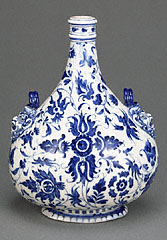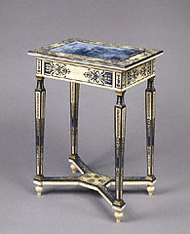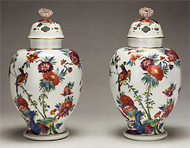Trade of both goods and ideas between Europe and the Far East has its origins along the famed Silk Road. This was not, of course, an actual road but rather a series of trade routes that led from China to the Mediterranean. Along this route, objects were traded that were rarely seen in the West—such as porcelain, tea, and the road's namesake, silk—all being passed from one merchant to the next and resulting in prices that only the wealthy could afford. The Silk Road brought isolated areas together through a trade that influenced and shaped culture and religion from China to the Italian Peninsula.
With the publishing of the travel accounts of Marco Polo in 1295, European audiences were introduced to the court of Kublai Kahn and never-before-heard-of wonders of the land of Cathay. Other accounts, such as letters from missionaries to China and the publication of Sir John Mandeville's Travels in 1480, further fueled the imagined Far East in Europe.
 |
||
Prior to the 1600s, the few objects from the Orient that had found their way to Europe, such as silks and porcelains, were highly valued for their beauty and durability. Chinese porcelain was unlike anything produced in Europe at the time, and its unique and beautiful decorations stirred the imagination of artists and collectors. Blue-and-white porcelain from China was so prized during the Renaissance that a number of princes attempted to discover the secrets of its production. Only in Florence, under the patronage of Grand Duke Francesco I de Medici, himself an amateur chemist, did alchemists succeed in developing an artificial, or soft-paste, porcelain. The example shown here, now in the Getty Museum collection, is one of only 64 pieces of Medici porcelain that survive today. The decoration on the vase takes its inspiration from Turkish patterns and Chinese blue-and-white porcelain designs.
The 18th century began with a fascination for all things "Chinese" in the courts of Europe—a fascination that would persist throughout most of the century. The trade routes to the Far East established by Spanish and Portuguese sailors in the 1500s increased the number of merchants, diplomats, and ecclesiastics traveling there, sparking a passion for Chinese and Japanese goods throughout Northern Europe. At this time the Chinese began producing large quantities of porcelain specifically for export to European markets. Finished porcelain pieces were sent down the Yangtze (pronounced "YAHNG-dz") River to Nanjing and to Canton, where Chinese merchants sold them to European traders. Parisian marchands-merciers (dealers of luxury goods) mainly purchased porcelain in Amsterdam from the Dutch East India Company. The volume of trade was enormous: in 1752, a ship headed for Europe sank with 223,303 pieces of porcelain on board.
 |
||
From the 1600s through the 1800s, the Chinese made vases for the European market, and wealthy Europeans eagerly collected them. Many European princes and nobles amassed large collections of Chinese and Japanese ceramics, installing them in rooms known as "China cabinets." There, porcelains decorated entire walls, with vases, plates, and cups set on brackets or overmantels, in cabinets, along shelves, and even on floors.
This taste for porcelain extended to numerous Chinese-style palaces, or pagodas, built in the Chinese style that were made for the nobility in Europe. The most famous of these was the so-called Trianon de Porcelaine built in 1670–1671 in the park at Versailles, the palace of Louis XIV. This structure, though mainly of European design (the only concession to Chinese architecture was a slight upturning of the corners of the roof), was faced with plaques of faience (since porcelain had yet to be created in Europe) painted to imitate Chinese blue-and-white porcelain. The blue-and-white color scheme was extended to the interior, where the paneling of the rooms was similarly painted. A table in the Getty Museum's collection was possibly part of the furnishings for the Trianon de Porcelaine, since the marquetry of ivory and animal horn, painted blue underneath, would have followed the house's blue-and-white color scheme, in imitation of blue-and-white Chinese porcelain.
After eagerly purchasing Chinese and Japanese wares, Germans finally discovered the formula for true, or hard-paste, porcelain in the first decade of the 1700s. As early as the 1670s, experiments had begun in Germany to discover the vital ingredients of the true hard-paste porcelain produced in China and Japan. The first factory to duplicate the recipe was the Meissen manufactory, established as the Saxon royal porcelain manufactory at Meissen, near Dresden, in 1710 under the patronage of Augustus the Strong (Elector of Saxony and King of Poland). It remained the dominant porcelain manufactory in Europe until about 1750, when its fame was eclipsed by the royal French porcelain manufactory at Vincennes (later called Sèvres).
The alchemist Johann Friedrich Böttger, the first director of the Meissen manufactory, initiated a period of experimentation and technical development. He first invented an extremely hard, red stoneware that could be polished, engraved, or cut in facets. Böttger's second discovery was the ingredient for white porcelain, kaolin, which is a pure, white clay named after a location in China. The form and decoration of the factory's wares were initially inspired by Chinese and Japanese porcelain in the Elector's collection. From Meissen, the formula for the production of true hard-paste porcelain spread throughout Europe.
 |
||
Imports from the Far East were to influence European art not only technologically but also stylistically. The fad for chinoiserie, roughly translated from the French as "Chinese-esque," refers to the European fine and decorative arts that incorporate subjects, motifs, and techniques that are evocative of China, Japan, India, and the Middle East. These diverse cultures constituted an idea of "the Orient" in the European imagination. Central to this "Chinese" style were objects that could be easily traded, such as silks, lacquer ware, and, above all, porcelain. Using the vast array of imported objects as models, European craftsmen began to copy the forms and decorative motifs used in eastern cultures. From this, Europeans developed their own new decorative style—emulating "Oriental" designs and adapting Asian motifs in imaginary and whimsical ways.
By contrast, the influence of European art upon the arts of China was originally thought to have been minimal. However, the exchanges between the two cultures were so significant that cultural borrowings and assimilations were apparent in both directions. The influence of Western art is most evident with the introduction of Western conventions of perspective and chiaroscuro into Chinese painting. Paradoxically, these Western techniques were then incorporated into the Chinese objects created for the Western market. The Emperor Qianlong (pronounced "chien-lung") (1737–1796) developed a taste for European art, going so far as to employ a Jesuit missionary, Giuseppe Castiglione (1688–1766), to paint for him in a hybrid European-Chinese style. Castiglione also worked as an architect for the Emperor, creating a European-style summer palace inspired by Versailles. It is interesting to note that at the same time Europeans were referring to people of the "Far East," the Chinese, in particular, referred to Europe as the "Far West." Through trade, East and West had met, and the resulting technological and stylistic exchanges had profound and lasting effects on both cultures.